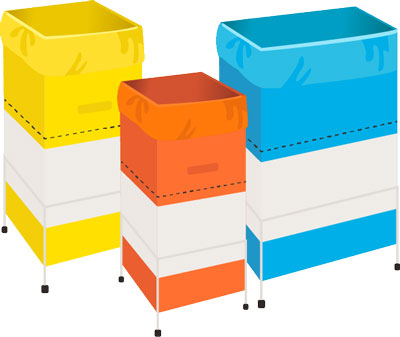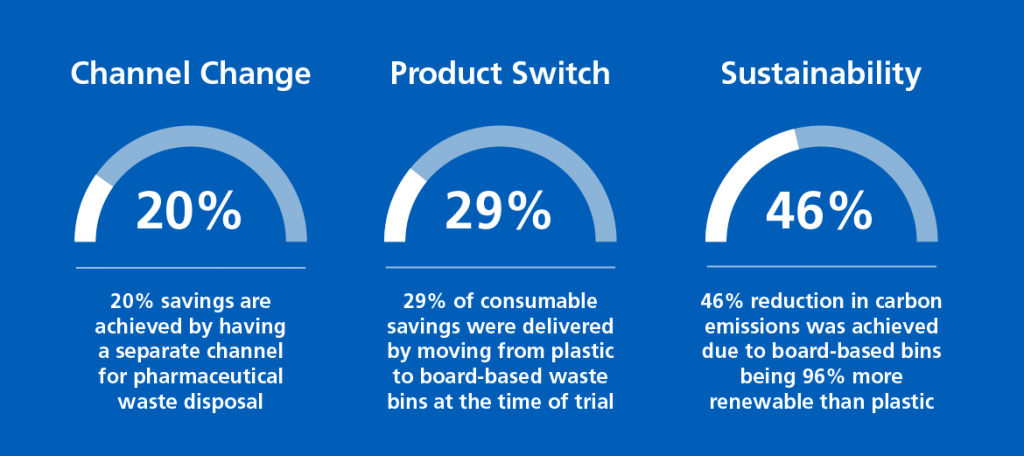Clinical Waste Disposal: Reducing Single Use Plastic within the NHS
We were able to switch from rigid plastic to rigid board-based containment for this waste stream which has helped our trust address the requirement to improve our environmental performance, generate savings whilst continuing to move towards fulfilling our sustainability objectives.Jason Mitchell, Waste Manager Newcastle Upon Tyne Hospitals NHS Foundation Trust

Overview
Reducing Waste Disposal
Prior to this implementation several years ago, Newcastle Upon Tyne Hospitals NHS Foundation Trust did not have a fully defined process in place for segregating some elements of healthcare waste. Non-hazardous pharmaceutical waste was disposed of in the same bins as hazardous waste.
As the disposal for hazardous waste is more expensive, their costs were being impacted. This practice was also non-compliant with HTM Guidance.
Following an internal review, the trust introduced blue-lidded plastic bins to allow pharmaceutical waste to be disposed of separately to other waste streams. With an increased focus on sustainability, they began looking at ways to reduce single use plastics; adopting board-based rigid containers for pharmaceutical waste. It was also apparent at the time that board-based alternatives were cheaper to purchase than plastic containers.
The Challenge
Implementing a new approach to waste disposal
To successfully implement this new approach to clinical waste disposal, the trust needed buy in from key stakeholders. There was a lack of awareness about the benefits of segregating pharmaceutical waste from its current method. Questions were raised regarding the quality and durability that board-based waste bins could provide when compared to plastic.
The Solution
Setting measurable objectives
Measurable objectives were set to evaluate waste disposal performance after implementation.
- Raise awareness of the effective benefits when using board based clinical waste disposal streams, across key hospital departments.
- Reduce the utilisation of single-use plastics when disposing of medical waste.
- Generate savings on pharmaceutical waste disposal.
- Successfully implement a segmented approach to waste disposal in line with trust policy within six months of completing a successful product trial.
Process Undertaken
Applying a structured approach to waste disposal
- Recognising the need to implement a more structured approach to waste segregation to reduce plastic usage in the waste process and to generate savings.
- Procurement and Waste Management worked together to identify opportunities and then engaged with stakeholders from across the Trust to increase awareness and adoption of waste segregation.
- Implemented a board-based blue non-hazardous pharmaceutical waste stream.
- Identified that board based bins offered a cost effective alternative – the specific products were selected due to in part the inclusion of an absorbent pad within the bin, allowing for medicinal waste to be added.
- Implemented to ‘friendly’ wards and departments including Pharmacy Stores, Clinical Research, specialist wards.
- Full implementation across 200 wards was achieved in a matter of weeks. Very straightforward roll-out.
The Result
A number of key savings were achieved

There have been recent developments in the healthcare waste industry, particularly around incineration outlets which, has led to a reassessment of pharmaceutical waste disposal.
As it is non-hazardous, the understanding is that it can be disposed of in permitted municipal incineration plants instead of specialist healthcare waste incinerators; providing it is clearly identified and appropriately labelled.
For the most part, this will bring cost savings and be completely compliant if the receiving site is permitted for 18 01 09 waste.
The following demonstrate our achievements:
- 20% savings were achieved through pharmaceutical waste disposal.
- 29% of savings were delivered through product switching.
- 46% reduction in carbon emissions.
Next Steps
The NHS Long Term Plan
The NHS Long Term Plan was published in January 2019. It outlines some key commitments to help the NHS be a low carbon institution and lead by example in sustainable development.
These commitments include:
- Reducing carbon emissions
- Improving air quality
- Reduction of single use plastics
- Improving efficiency and adopting new innovations to reduce waste, water and carbon.
Despite a 27% increase in activity, the carbon footprint of health and social care has reduced by 19% since 2007.
This still leaves a significant challenge to deliver the Climate Change Act target; the target of which is 34% by 2020 and 51% by 2025.
The NHS as an organisation has a huge carbon footprint. A large percentage of which is from the procurement of goods and services. Waste is a contributor to that carbon footprint. In addition, the plan responds to the global concern over single use plastics. Any activity which reduces plastic and reduces waste will be helping the NHS to deliver on its carbon reduction commitment. This will help make the NHS an anchor institution in sustainable development.
What You Can Do Now
See our Useful Links section to view the framework for clinical waste containers.
To convert your Clinical Waste Containers to Board-Based Containers firstly, please review your requirements in collaboration with your trust’s Infection Control, Procurement and Waste Management team.
If you are interested in exploring the benefits of product switching, NHS Supply Chain can support by:
- Facilitating supplier discussions.
- Outlining the products available via the online catalogue.
- Providing dedicated Account Management support.
Useful Links
-
Account Managers
Find contact details for your NHS Supply Chain Account Manager.
